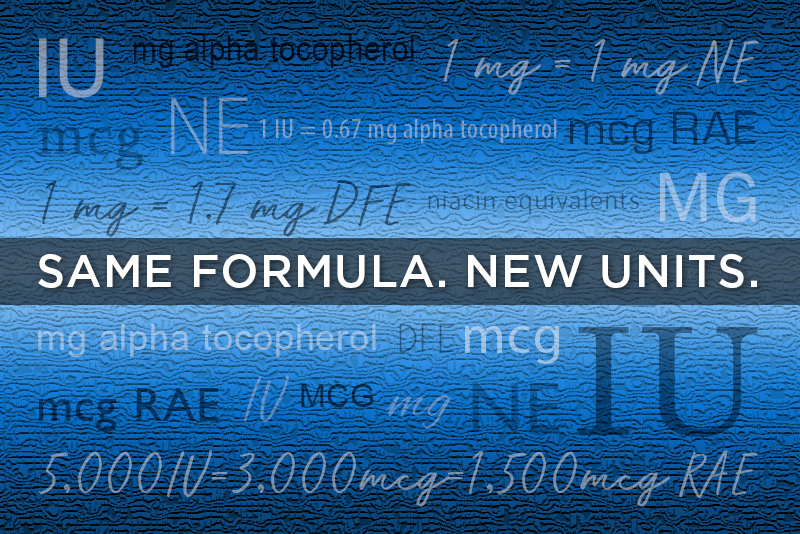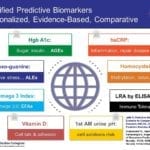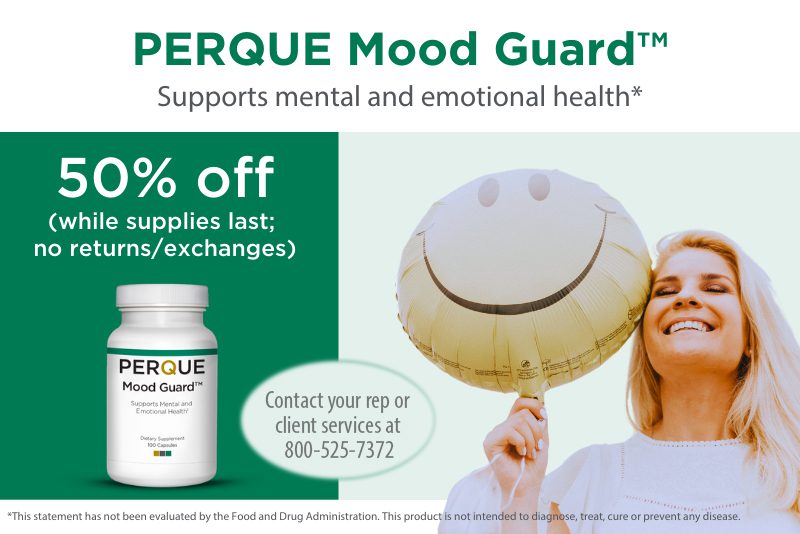Beginning in January 2020, supplement companies have been required to comply with several new FDA labeling regulations. In keeping with these regulations, there are changes that we at PERQUE have had to make in our product labels. This blog will help you navigate these changes, which for many can be a tad confusing.
The main changes are in the following nutrients:
Vitamin A/Beta Carotene, Vitamin D, Vitamin E, Niacin and Folate
Vitamin A/Beta-carotene:
Since PERQUE only uses the plant-based form of vitamin A (beta carotene), you will see unit changes referring to only beta carotene. This needs to be reported now as RAE or Retinol Activity Equivalence. See table below for conversions to this unit and back to the familiar unit – IU
Vitamin D3
Vitamin D will also be moving from IUs to mcg on the product label. 1 mcg of vitamin D3 equals 40 IUs. PERQUE D3 Cell Guard that has 500 IU of vitamin D3, when converted to mcg = 12.5 mcg.
Vitamin E
Alpha-tocopherol is the only tocopherol that can be considered when determining the vitamin E content of a supplement which is what is reflected in the units. Since we at PERQUE provide Vitamin E as mixed natural tocopherols, the amount of mixed tocopherols in the formula will be listed in parentheses before the vitamin E claim
Folate
Folate has a new unit of measure called Dietary Folate Equivalents (DFE). Because supplemental sources of folate are considered more potent than food sources of folate they will have a higher DFE than folate in food sources. So although PERQUE has not changed the current formulations, you will see an increased label claim and Percent Daily Value (%DV). To make the conversion you multiply the previous folate claim by 1.7. For example, 1 mg of 5-methyltetrahyrofolate (as listed on a previous label) will now be listed as 1.7 mg DFE, no matter what the folate source (5-MTHF and/or calcium folinate). The actual amount of folate we are putting in the supplements is the same as always and will be noted in parentheses.
Niacin
New guidelines require that niacin be reported as Niacin Equivalents (NE) to take into account the fact that dietary niacin can come in several forms such as niacin, niacinamide, inositol hexanicotinate.
Please refer to the table below for a concise list of the above new units and their conversions
| Nutrient | Current Unit | New Unit | Conversion | To convert back |
| Beta carotene
(Vitamin A) |
mcg (1 IU of Vitamin A = 0.6 mcg beta carotene | mcg RAE | 1 mcg RAE = 12 mcg beta-carotene | Divide by 0.15 to get IU |
| Vitamin E | IU | mg | 1 IU = 0.67 mg alpha tocopherol | Multiply by 1.49 to get IU |
| Vitamin D | IU | mcg | 1 IU = 0.025 mcg | Multiply by 40 to get IU |
| Niacin | mg | mg NE | 1 mg NE = 1 mg niacin/niacinamide and inositol hexanicotinate | |
| Folate | mcg | mcg DFE | 1 mcg DFE = 1.7 x amount in mcg of natural folate (Calcium folinate or 5 MTHF)* | Divide by 1.7 |
* The FDA allows manufacturers to use either a conversion factor of 1.7 to be comparable to folic acid, or their own established conversion factors not to exceed 1.7
mcg: microgram. One millionth of one gram.
mg: milligram. One thousandth of one gram.
IU: International Unit is a measure of biological activity and is different for each substance.
RAE: Retinol Activity Equivalent.
DFE: Dietary Folate Equivalent
NE: Niacin Equivalent.
For more info:
https://dietarysupplementdatabase.usda.nih.gov/Conversions.php
https://ods.od.nih.gov/factsheets/Folate-HealthProfessional/#en11
Did you enjoy this post? We post new content regularly! Click here to see our latest blog posts.






